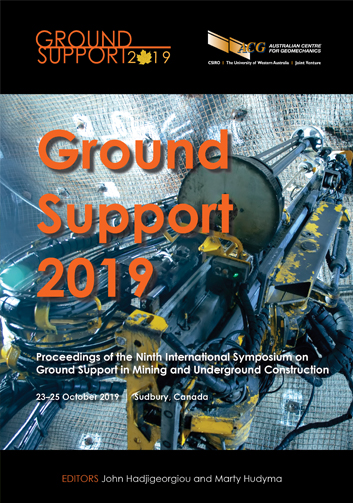Numerical investigation of dynamic response of a rockbolt under drop testing and simulated seismic loading conditions

|
Authors: Zhang, P; Nordlund, E |
DOI https://doi.org/10.36487/ACG_rep/1925_26_Zhang
Cite As:
Zhang, P & Nordlund, E 2019, 'Numerical investigation of dynamic response of a rockbolt under drop testing and simulated seismic loading conditions', in J Hadjigeorgiou & M Hudyma (eds), Ground Support 2019: Proceedings of the Ninth International Symposium on Ground Support in Mining and Underground Construction, Australian Centre for Geomechanics, Perth, pp. 387-398, https://doi.org/10.36487/ACG_rep/1925_26_Zhang
Abstract:
When designing rockbolts for rockburst conditions, it is commonly assumed that the kinetic energy of an ejected rock block is absorbed by rockbolts. To obtain the energy absorption capacity of a rockbolt, drop testing has been widely used. The advantage of using a drop test to investigate the dynamic performance of rockbolts is that it can provide repeatable results. However, it is recognised that the drop test technique is a crude simulation of an actual seismic loading mechanism. To investigate the difference, numerical models were constructed to simulate the response of a rockbolt under both drop testing and simulated seismic loading conditions using the numerical code UDEC (Universal Distinct Element Code, Ver 6.0) (Itasca Consulting Group 2018). The seismic wave is simplified as a full cycle sinusoidal wave which generates the same ejection velocity magnitude on a reinforced rock block as the drop test. The rockbolt was found to fail under the simulated seismic loading condition but survived the drop test. This difference is because reflected seismic waves create additional displacement between the ejected rock block and adjacent rock block. The results indicate that impact energy or kinetic energy should be used carefully when determining the dynamic demand on rockbolts as it does not consider the critical interaction between seismic waves and the reinforced rock blocks. Additional parameter sensitivity studies showed how the frequency of a simulated seismic wave affects the dynamic response of rockbolts. The results can be used to improve our understanding on the dynamic response characteristics of ground support. The knowledge gained from the comparison can be used to improve the estimation of dynamic demand on rockbolts under rockburst conditions.
Keywords: drop test, seismic loading, dynamic response, rockbolt, numerical simulation
© Copyright 2025, Australian Centre for Geomechanics (ACG), The University of Western Australia. All rights reserved.
View copyright/legal information
Please direct any queries or error reports to repository-acg@uwa.edu.au
View copyright/legal information
Please direct any queries or error reports to repository-acg@uwa.edu.au